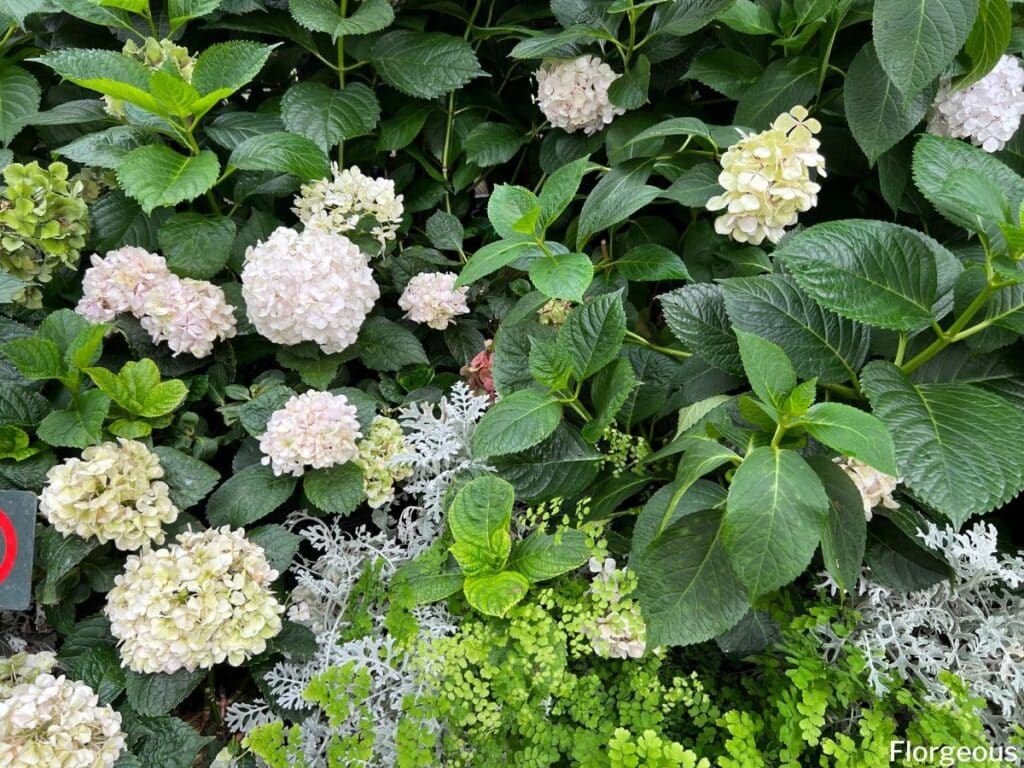The hydrangea is a garden staple – and if you’re considering growing hydrangea companion plants, that’s a wise choice.
There are certain plants that, when grown next to hydrangea bushes, benefit from similar growing conditions and offer similar visual appeal. Not only that, but hydrangeas offer various advantages to plants growing nearby.
If you’re wondering what to plant next to hydrangeas, here’s what you need to know:

What to Plant with Hydrangeas
There are a few companion plants you may want to consider growing with your favorite flowering shrubs.
One of the best companion plants is American beautyberry. A fast-growing shrub, it thrives in the same conditions as hydrangeas. These beauties provide a great anchor with their waxy, deep green foliage. Plus, its beautiful purple berries add additional interest and can attract wildlife to your hydrangea garden.
Lacy, delicate ferns also grow well with hydrangeas, as do hostas. These species prefer partial shade, but since they’re often smaller than hydrangeas, can thrive in their shadows.
Medium-sized trees grow well with hydrangea plants and offer the benefit of additional shade during hot weather. Dogwood can help keep your hydrangea cool while also providing visual appeal in its blossoms, bark, and lush foliage.
Japanese forest grass (Hakonechloa) is an excellent companion for Hydrangeas in the garden. Its gracefully arching blades provide a contrasting texture and a vibrant green backdrop, enhancing the overall aesthetic appeal and complementing the hydrangea’s blooms.
Finally, you may want to grow a few shade-tolerant flowers in front of your shrubs. These can often fix nutrients in the soil while benefiting from the shade of your taller shrubs. Pansies, heuchera, and foxgloves are all excellent choices.
Other great plants that look good with hydrangeas include:
You can even grow ornamental grasses or annuals with your hydrangeas to really shake things up!

Specific Hydrangea Landscaping Ideas
Some great companion plants for oakleaf hydrangea include purple coneflower, hosta, astilbe, ferns, liriope muscari, and catmint.
For border limelight hydrangea companion plants, try small shrubs such as roses, azaleas, spirea, boxwood, and weigela or flowers such as coleus, and impatiens to create a mixed border or hedge.
With bobo hydrangea companions, we suggest hardy geranium, creeping Phlox, impatiens, dwarf iris and border shrubs such as boxwood.
You can pair Endless Summer® Hydrangea bushes with inkberry, astilbes, nepeta, viburnum, hosta, bleeding heart and Siberian iris.
Some flowering plants to mix with Incrediball hydrangea and Annabelle hydrangea include azalea, roses, catmint, helenium, black-eyed Susan and Russian sage.
Some Pinky Winky and Vanilla Strawberry hydrangea landscaping ideas include sedum ‘Autumn Joy’ and coral bells. But honestly, these gorgeous plants already look so amazing by themselves.
Twist and Shout hydrangeas work well with boxwood, dwarf burning bush, and small yellow daylily.
For a beautiful mixed border that compliments Quick Fire Hydrangea, you can plant astelia nivicola, hosta, and carex conica.

Are Hydrangeas Poisonous to Other Plants?
There is a misconception out there that hydrangeas are poisonous to other plants, and therefore, that you need to select companion plants carefully to make sure you don’t accidentally kill the rest of your garden. However, that is not the case.
These shrubs can be dangerous – but not to other plants. Instead, they can actually be dangerous to you. They contain a toxic compound in their stems, leaves, and flowers. This compound is known as hydrangin, which converts to cyanide in the digestive system and can lead to serious stomach upset.
Poisoning is rare in humans but can occur in pets and small children when large amounts are ingested. Therefore, it’s a good idea to choose your hydrangea planting location wisely – but only in terms of where animals and kids can get to your shrubs (and not necessarily based on the surrounding plants).

Tips for Selecting Companion Plants for Hydrangeas
Here are some tips to consider when you’re choosing companion plants that will not only grow well with your hydrangea shrubs but will create an ornate display in your landscape.
1. Ideal Growing Conditions
Consider the preferences of your hydrangeas when you’re trying to decide where you will plant them. Some varieties, like mophead (Hydrangea macrophylla), produce blue hydrangea blooms in acidic soil and pink ones in alkaline soil.
Most hydrangeas like full sunlight in the morning with a bit of dappled shade in the afternoon. ALmost all like soil that is consistently moist, though not soggy. Oakleaf hydrangea bushes prefer moist soil.
It’s important to consult the label on your plant before you put it in the ground (and before you select companions). That way, you can make sure the ideal conditions will be provided.
2. Consider the Canopy
Start by selecting canopy plants that will give a bit of shade to your hydrangea bushes. Medium-height trees like dogwood can deliver a bit of shade while also providing their own visual appeal in their foliage, flowers, and bark.
Other good options include evergreens, crape myrtles, and more.
3. Plant a Mixture of Deciduous and Evergreen Plants
Don’t be afraid to shake things up when you’re planning out your hydrangea-centric landscape. When combined, evergreen and deciduous shrubs create an interesting aesthetic – plus, you’ll have some foliage left to enjoy in the winter, too.
Pairing plants like yew, mahonia, and others will ensure that you have something to look at throughout all seasons!
4. Grow a Carpet
Last but not least, don’t forget to include the plants that will be grown at your hydrangeas’ feet. You may want to add groundcovers like loropetalum or heuchera. These will lend some elegance to your garden while also suppressing weeds and helping to retain moisture around your shrubs.
Where Should You Not Plant Hydrangeas?
For the most part, you can plant hydrangea shrubs just about anywhere as long as the location has fertile soil and receives a bit of morning sun paired with afternoon shade. Avoid planting your shrubs in areas that receive deep shade or shade most of the day – or on the flip side, total sun all day.
There aren’t many plants that don’t grow well with hydrangea bushes (with the exception of those that prefer opposing growing conditions, such as full shade, full sun, or dry soil). You may want to avoid options like lavender, periwinkle, or rosemary, for example.
Otherwise, you have thousands of choices when it comes to finding the perfect plants to grow alongside limelight hydrangeas, Hydrangea macrophylla (French or bigleaf hortensia) and other hydrangea types. You can choose freely based on your visual preferences, landscape, and growing zone. Happy planting!
FAQs
Can you plant hydrangeas and roses next to each other?
Yes, hydrangeas and roses can be planted next to each other in a garden. Both plants have similar growing requirements, including well-draining soil and adequate sunlight, and their complementary colors and textures can create a visually appealing and harmonious garden setting.
Do Hydrangeas like coffee grounds?
Yes, hydrangeas generally benefit from the use of coffee grounds as a soil amendment. Coffee grounds can help increase the acidity of the soil, which is favorable for hydrangeas, especially if you want to encourage blue flower color in certain varieties.
References
See more:







